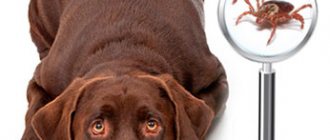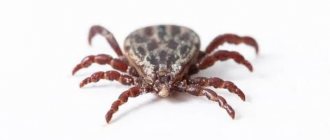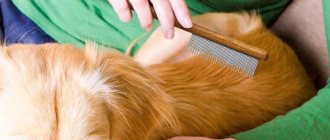- November 14, 2019
- Parasitology
- Elena Kerra
After a walk outside, owners often find a tick on their dog's body. What to do in this case? How to remove a tick? How to treat the wound? What drugs will protect the animal from parasite attack? Is a tick bite always dangerous for a dog? What diseases does it cause? What types of ticks can parasitize dogs? What drugs exist to combat parasites? The article provides answers to all these questions.
Types of ticks
Dogs are pets that definitely need to be walked outside. Animals need to relieve themselves, run, and frolic. Many owners teach their pets commands during walks. Hunters take dogs with them to help them hunt for game. Whether in the forest, in a city park, or on a walking area, pets are at risk of being attacked by ticks.
Many owners have seen small brownish or grayish sacs the size of a pinhead on their dog’s body. This is a sucking tick. However, you are mistaken if you think that this is the only way a parasite can look. In nature, there are many types of ticks that parasitize dogs. Some of them are dangerous to humans. All mites are divided into two groups: subcutaneous and external. Subcutaneous ones include:
- sarcoptoid;
- scabies;
- hair
Types of external mites:
- ixodidae;
- argasaceae;
- ear;
- cheyletiella.
Let's take a closer look at each of them, as well as methods for treating pets.
The process of a tick attacking a dog.
Hungry ticks find their prey thanks to the presence of special thermal sensors. A dog passing by a bush or grass on which a tick is sitting becomes an object of attack, the tick makes a jump and, clinging to the hair, remains on the dog.
Having latched onto a dog, the tick begins to look for the place on the dog’s body that is least covered with hair (skin around the ears, neck, legs, abdominal area, etc.). Further digging into the skin with its tentacles, the tick pierces the skin and begins the process of sucking blood. It becomes almost impossible to tear it away from the dog at this time, and only after the tick has completely drunk blood does it fall off the dog’s skin.
Ixodid ticks
This is a whole family of arthropod parasites, numbering 650 species. On the territory of Russia, the highest danger is represented by dog ticks (they infect not only animals, but also humans) and taiga ticks.
Above we have listed places where a dog can be infected with these blood-sucking parasites. They climb onto branches of bushes or trees located low to the ground, on blades of grass and wait for their prey. If a dog passes in this place, the tick will jump or simply fall on it.
These arthropods are quite small. In a hungry state, their body length does not exceed 5-7 mm, and the colors can be of various shades. If you find a tick on your dog's fur, what should you do? You need to carefully remove it and kill it. If he has not yet had time to attach himself, then he does not pose any danger.
Once on the animal’s fur, the parasite strives to quickly reach its body and dig into the flesh. The tick's mouthparts are ideally suited to this. It is equipped with a dense chitinous proboscis with hooks, at the base of which there are salivary glands. The tick injects the victim with saliva containing blood anticoagulants (they prevent blood clotting) and painkillers. Therefore, the animal does not feel the bite. A tick that has drunk blood increases in size several times. Its body takes on a brownish or grayish tint.
Why are ixodid ticks dangerous?
These parasites transmit diseases that often cause death in infected animals and humans. Ticks cause the following diseases:
- encephalitis;
- piroplasmosis;
- bartonellosis;
- borreliosis;
- hepatozoonosis;
- ehrlichiosis.
The parasite's bite can cause these diseases if it itself is infected. If not, then the incident will end without such serious illnesses. The main thing is to correctly remove a tick from a dog.
The parasite's saliva contains not only an anticoagulant and anesthetic, but also a specific protein. Once in the victim’s body, it hardens almost instantly, creating a kind of “cement” case around the proboscis. Therefore, it is very difficult to remove a tick. Often owners tear off only its body, leaving the head in the pet's body. As a result, the animal may begin to suppurate in that place. If microbes enter the wound, a secondary infection will occur.
If you see a parasite attached to your pet’s body, do not even think about tearing it off. It is best to remove a tick from a dog at a veterinary clinic. But you can do this at home if you know a few rules.
Folk remedies for ticks
Folk remedies have no proven effectiveness; they are used for mild forms of the disease and in the initial stages to alleviate the pet’s condition.
- Garlic. Garlic cloves are crushed and poured with almond oil (1:2). After this, they are placed in a dark place for 3-4 days. The resulting tincture is applied to the affected areas.
- Sulfuric ointment. Helps with scabies.
- Black sulfur. Used as part of kefir tincture (1:3).
- Lavender oil. Apply to the skin. When the oil is absorbed, rub the affected areas with chalk powder.
- Vanillin. Vanillin is infused in water or vodka, and the dog’s fur is treated with this solution before going outside.
You should not abuse any of these products - they act very aggressively on the dog’s skin: they cause burning, dry it out, provoke allergic reactions and other negative consequences.
As a preventive measure against ixodid tick bites, the following are used in folk medicine:
- Essential oils. The pet's fur is rubbed with oils: lavender or tea tree.
- Tar soap. Use it while bathing - it is an excellent therapeutic and prophylactic remedy.
- Sagebrush. Spray your dog with a water tincture of wormwood.
You can prepare a remedy for ticks at home from an aqueous solution of tar soap, myrrh, tea and rose tree, juniper and grapefruit oils. Fill a bottle with a spray bottle with the resulting mixture and spray your pet before a walk in the country or in the park.
Removing a tick
If you don’t have the opportunity to contact a specialist, take on the matter yourself. For this you will need tweezers. Returning from a walk, you must first carefully examine your pet. Ticks prefer those areas of the body where blood vessels are located closer to the outer layer of the skin. This:
- head (especially in the area of the nose and ears);
- neck;
- groin;
- inner surface of the paws.
However, the tick can attach itself elsewhere. Having discovered a parasite, you need to prepare to remove it. It is advisable to trim the dog's fur around the tick. This area should be lubricated with one of the following products:
- any oil;
- kerosene;
- petrol;
- vodka;
- medical alcohol.
Oily solutions will cut off oxygen to the tick, so it will try to leave the victim’s body on its own. Products with a strong odor will also force it to leave. If it does not fall off on its own within 30 minutes, the liquids listed above will still force it to loosen its grip and stick out its proboscis a little.
You must pinch the parasite with tweezers. Try to position the tool as close to the dog's body as possible. Next, begin to slowly twist the parasite clockwise or counterclockwise and at the same time gradually pull it towards you.
You can use a thread that must be tied in a knot near the dog's skin to capture the head of the tick. Next, you need to start rocking the parasite a little, and then remove it in the same way as with tweezers.
Alternatively, you can use a small volume syringe. It needs to be cut at the place where the needle is inserted. Further algorithm of actions:
- lubricate the dog’s body with some greasy product (for example, Vaseline);
- Place the syringe so that it captures the tick and press it against the dog’s skin;
- slowly raise the plunger, drawing the parasite into the syringe.
This method removes not only the tick, but also its saliva. However, a hematoma may remain on the animal's body.
If a tick head remains in your pet’s body, what should you do? In this case, the dog may experience a purulent infection and skin necrosis. Therefore, the remains of the parasite must be removed. It is better to do this in a veterinary clinic. The animal is given an anesthetic injection and the head of the arthropod is removed using a special tool. The site of a tick bite on a dog should be lubricated with any disinfectant.
When you remove the bloodsucker from your pet’s body, it must be placed in some container with a lid and taken to the laboratory. There they will find out whether he is a carrier of a dangerous disease.
How to protect your dog from infection
It is difficult to predict whether your pet will pick up ticks on his next walk or not. It is also impossible to know in advance whether the parasite will be a carrier of infection. To eliminate risks, veterinarians recommend vaccination. This is especially true if you live in areas unfavorable from the point of view of the epidemiological situation.
If you don't want to give your pet a vaccine, you can use tick repellents. Types of drugs:
- pills;
- sprays;
- drops on the withers;
- collars.
Drops are the most popular remedy. The anti-tick drug “Bars” for dogs is in demand. Reviews about it are mostly good. Pet owners write that the product does not have an unpleasant odor and effectively protects not only from ticks, but also from fleas. However, Bars may cause allergic reactions, which should be taken into account when using it.
Many owners are interested in how to treat a nursing dog against ticks. "Bars" contains diflubenzuron, fipronil and dicarboximide. The product is classified as moderately dangerous. Pregnancy and lactation are indicated by the manufacturer as contraindications. Tablets and sprays cannot be used either.
Collars will help protect a pregnant dog from ticks. They are impregnated with a special composition that is not absorbed into the animal’s blood and repels parasites. There are also shampoos and drops produced specifically for pregnant and lactating females. As a rule, they contain plant extracts and non-toxic substances.
If there are risks, veterinarians advise using soap and herbal decoctions: tansy, wormwood, lavender, rosemary. However, before using them, you should consult a veterinarian, since even natural substances can cause an allergic reaction.
Precautions when examining infected animals
When examining your pet at home, follow these simple rules:
- always use disposable gloves;
- before and after the examination, do not forget to treat your hands with a disinfectant solution;
- If you find external ticks, do not squeeze them with your fingers or foreign objects;
- Always cover the inspection area with a clean cloth or oilcloth and then discard it.
A pet that is sick and tormented by parasites is usually in a depressed state. Try to calm him down and reward him with a treat for good behavior. If the dog is excited and does not obey, do not raise your voice or create a nervous environment. Care and affection will strengthen trust and love for the owner.
Try to be patient with the animal's behavior and calm it down as much as possible.
Ear mites
These parasites can only be seen with a microscope, since their sizes are extremely small (up to 0.5 mm). They parasitize in the ears of animals, but in some cases they can migrate to the head. The disease is caused by otodectosis.
Dogs become infected with this mite from other animals, as well as through grooming items (combs, beds). Even the owner can bring the parasite into the house on shoes or clothes.
How to detect ear mites on a dog? Signs appear only 2 weeks after infection. The arthropod gnaws passages in the ears, in which it lays eggs. The parasite also pierces the victim's skin to extract lymph and blood. All this causes the dog to itch. She begins to scratch her ears and scratch them with her claws. Some animals press their heads to the floor and sit in this position.
Another important sign is dark crusts in the ears. They are a mixture of sulfur and parasite excrement.
If the animal is not treated, it may die. The fact is that the parasite eventually gnaws through the eardrum. As a result, pus enters the inner ear and then onto the lining of the brain. A less sad outcome is the animal’s deafness.
How to get rid of ear mites in dogs? Treatment is carried out by external means. These are drops, ointments, sprays. The animal's ears must be treated with the preparations according to the attached instructions.
Veterinarians often prescribe Bars for ear mites in dogs. In reviews, owners write that the product acts quite quickly. After the first use, the pet stops intensively scratching its ears. However, the treatment must be carried out for a long time (at least a month).
Among the shortcomings of the product, the owners point out its too unpleasant smell and not entirely harmless composition. Bars ear drops contain diazinon, which is a toxic substance. In addition, in some reviews, pet owners note that the product caused allergic reactions in their pets, which then had to be treated.
Other drugs used in the treatment of otodectosis:
- "Surolan";
- "Oricin";
- "Otoferonol Gold".
If the disease is advanced, the dog is given injections. Preparations:
- "Ivomek";
- "Aversect-2";
- "Cydectin".
Video: how to get a tick at home
In order to remove the tick accurately and not harm the dog, you should have a good understanding of the removal technique. The video below shows manual removal. The dog breeder does not recommend using oils, vodka or other liquids to block his access to oxygen. The owner of the dog, who uses a means at hand to remove the insect, notes that it is not worth pulling or pressing on the tick, otherwise it will stick even stronger. After removing the arthropod, the wound is treated with disinfectant iodine, and the ixodid tick is destroyed.
How to get a tick using improvised means
Scabies mite
This parasite can also only be seen under a microscope, because its body size does not exceed 0.5 mm. It parasitizes under the skin of its victim, where it feeds and reproduces. Can be transmitted to humans. The disease is caused by notoedrosis.
Your pet can pick up scabies mites from other animals or through grooming items. Sometimes owners bring the parasite into the house on shoes or clothing. The tick gnaws passages under the skin where it lays eggs. At first, the parasite is localized on the animal's head, but over time it spreads throughout the body.
How to detect scabies mites in a dog? Signs of notohedrosis are as follows:
- severe itching;
- scratching on the skin (other pathogenic microorganisms can get into the wounds, causing suppuration and dangerous diseases);
- hair loss;
- dog irritability, loss of appetite, lethargy.
If treatment is not started in time, the animal may die. How to get rid of scabies mites in dogs? The treatment is complex:
- The animal needs to be injected with vitamins “Gamavit”, “Gamapren” or analogues.
- Give antihelminthic drugs.
- Redeem. In nursery conditions, a solution of colloidal sulfur is used. It's difficult to do this at home. Veterinarians recommend applying a 60% solution of “Hyposulfite” to the affected areas of the dog’s body. After drying, the skin is wiped with a 5% solution of hydrochloric acid. In this case, the animal should not be allowed to lick itself.
- If all else fails, give Ivomeca injections.
How to treat piroplasmosis in an animal
If you find one of the symptoms of piroplasmosis in your dog, you should immediately consult a doctor. The sooner a specialist prescribes treatment, the higher the chance of the animal’s future well-being, because even cured pathology can provoke liver and kidney diseases. The first thing to do is to destroy the Babesia that causes the disease. To do this, the doctor injects the dog with a special drug, after which the microorganisms are removed along with the affected red blood cells, and maintenance therapy is also prescribed. After administering the medicine, the dog feels better, usually on the third day.
- Vasodilators for high blood pressure
- Lung cancer - symptoms and signs in women and men
- Cranberry sauce - recipes with photos. How to make cranberry sauce for meat, poultry or fish
Sarcoptoid mite
It is often confused with scabies because it also causes scabies. The routes of infection and symptoms of infection with these two types of parasites are identical. The animal itches a lot and injures the skin with its claws. In these places, pustules form, inflammation, and dandruff appears. Without treatment, bald spots appear on the body of an infected animal, and exudative dermatitis may occur.
The pet begins to weaken, its protective properties of the body decrease.
To carry out diagnostics to detect the parasite, scrapings are taken.
Owners are interested in what inexpensive anti-tick medications are available for dogs. If your pet is diagnosed with sarcoptic mange, bathing with tar soap is recommended. This option is the most economical, but quite effective. You can also use antiseborrheic shampoos, for example Oxymed, Animall Vetline, Veterinary Formula.
Heyletiella
This is a family of mites with several species. All of them are extremely contagious and dangerous for both animals and humans. The disease is caused by cheyletiellosis (wandering dandruff).
You can become infected through contact. In addition, flies and fleas carry ticks on their paws. Cheyletiella are very small. Their body length varies from 0.25 to 0.5 mm. Once on the skin of its victim, the parasite begins to actively multiply. Symptoms of infection:
- small reddish pimples on the skin;
- dandruff (contains live mites);
- peeling;
- itching (sometimes may be absent).
If this type of tick is found on a dog, what should you do? First, you need to minimize tactile contact with the animal. You cannot pick him up or allow him to lie on your bed or on the sofa. It is recommended to bathe the dog periodically using shampoos:
- "Sweetheart";
- "Gamma";
- "Demos Lux".
Another treatment option is to treat the animal with solutions of the following drugs:
- "Butox";
- “Unoiled.”
You can also use aerosols:
- "Acrodex";
- "Ciodrine";
- "Psoroptol."
With any treatment regimen, you need to inject the animal with Gamavit or its analogues.
Argasid mites
These parasites are relatively large. The length of their body can vary from 3 mm to 3 cm. Argas mites hide in all sorts of cracks, caves, and outbuildings, waiting for their prey.
There are no anesthetics in their saliva, so the bites are quite painful. The animal becomes agitated and often looks around in search of the source of the discomfort caused. What does a tick bite look like? The dog develops a dark red spot on its skin. There is a slight swelling in this area. In the future, suppuration may occur. The animal begins to scratch the bite site.
The saliva of argas mites is toxic. In a dog, their bites can cause trembling in the body, weakness, and increased salivation. The animal's pupils dilate, pulse and breathing become impaired.
Pet owners need to know what a tick bite on a dog looks like in order to take timely action. Otherwise, the pet may die. Veterinarians recommend treating animals with acaricides “Medilis” and “Ectometrin”. For preventive purposes, it is necessary to treat areas where pets can become infected with dust.
The most common diseases carried by ticks
Babesiosis (pyroplasmosis)
An invasive disease caused by the microscopic parasite Babesia. This microorganism multiplies in red blood cells. Pathological changes in the dog’s body are associated with the fact that there are fewer and fewer normal red blood cells, and more and more decay products of infected ones. First of all, the kidneys and liver suffer, which are forced to remove many toxins against the background of progressive anemia. Unfortunately, without adequate treatment, the disease most often ends in the death of the animal. The main symptoms of babesiosis are as follows.
The dog becomes lethargic, apathetic, and loses its appetite. Temperatures will rise to 40 degrees and above. Urine takes on a reddish or brown tint. There is stiffness in movements. Anemia develops, then jaundice, the mucous membranes of the eyes and mouth turn pale or acquire a yellowish tint. Diarrhea may develop, often with blood. At the end of the disease, the animal often falls into a comatose state.
With babesiosis, it is very important to seek veterinary help as soon as possible, before changes in the body become irreversible.
Canine borreliosis (Lyme disease)
The causative agent of this disease is bacteria. At the site of an infected tick bite, a characteristic focus of inflammation usually forms in the form of a red spot, which becomes lighter in the center over time. The main symptoms of the acute form of Lyme disease include an increase in body temperature to 40–42 °C, arthritis and occasional lameness (usually the animal limps on the paw that is located in close proximity to the bite site). This condition can be observed for 2–3 days, after which the disease subsides for a long time. Therefore, at the first unfavorable signs, the dog must be shown to a veterinarian, who will prescribe the necessary treatment. As the disease progresses, animals may develop apathy, severe weight loss, and various neurological disorders. After months and years, joint inflammation and lameness often return.
Ehrlichiosis
The causative agent of this disease affects white blood cells, in particular monocytes. Manifestations of ehrlichiosis are nonspecific; the main symptoms are depression, lethargy, loss of weight and appetite. Later, fever develops with hemorrhages on the skin and mucous membrane, and sometimes vomiting, lameness and shortness of breath are observed. The acute course of the disease can end in self-healing or become chronic with progressive degeneration, swelling and nervous symptoms. With ehrlichiosis, it is very important to make a correct diagnosis, so do not neglect a visit to the veterinarian.
Demodexes
They are called hair mites because they parasitize hair follicles. Causes the disease demodicosis. Hair mites are very small. One bulb can house a whole colony of them.
These parasites are considered conditionally pathogenic, since they do not manifest themselves as long as the animal has a sufficiently high immunity. If the dog is weakened, for example after illness or surgery, the tick develops vigorous activity, causing hair loss. The disease can appear in one area of the skin or throughout the animal's entire body.
Canine demodicosis does not spread to humans. Rottweilers, dachshunds, German shepherds, collies, and boxers are most susceptible to it.
Ointments “Yam” and “Parmethrin” are used for treatment. These remedies are considered the best if the disease is localized in certain areas of the dog’s body. In the generalized form, doctors prescribe tablets “Ivermectin”, “Milbemax”, as well as drops “Advocate”, “Advantis” and others.
Ticks are very dangerous blood-sucking parasites. Dog owners should carefully examine their pets after each walk, take preventive measures, and if the animal becomes infected, begin treatment on time.











